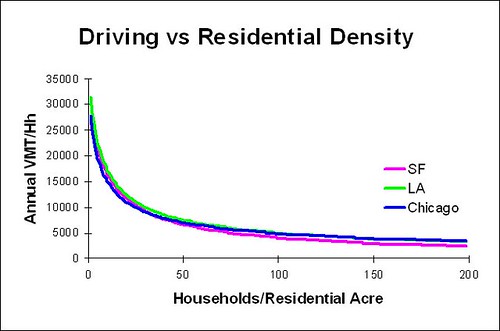Watershed benefits of smart growth duplicate transportation benefits, according to recent research

Posted June 1, 2010 at 1:39PM
Research findings published last year in the Journal of the American Water Resources Association confirm earlier studies by the federal Environmental Protection Agency showing that, for a given increment of development, compact neighborhoods built to a walkable scale reduce stormwater runoff volume. The article, written by John Jacobs, director of the Texas Coastal Watershed Program and Ricardo Lopez, a faculty member at Baylor College of Medicine, quantifies the per-capita impacts of different residential densities on watersheds, finding that the benefits of relative density (compared to sprawl patterns) begin at around 8 units per acre, increase substantially up to around 32 units per acre, and then continue but at a diminishing rate of increase after 64 units per acre:
“For a constant or given population, then, higher density can result in dramatically lower total loadings than more diffuse suburban densities.
The model showed that a simple doubling of standard suburban densities [to 8 dwelling units per acre (DUA) from about 3 to 5 DUA] in most cases could do more to reduce contaminant loadings associated with urban growth than many traditional stormwater best management practices (BMPs), and that higher densities such as those associated with transit-oriented development could outperform almost all traditional BMPs, in terms of reduced loadings per a constant population. Because higher density is associated with vibrant urban life, building a better city may be the best BMP to mitigate the water quality damage that will accompany the massive urban growth expected for the next several decades.”
The findings are important because they suggest that water quality officials should both encourage walkable and transit-supportive densities and take care to ensure that stormwater regulation does not discourage such densities, as some have charged that it does.
What is most striking to me is that the shape of the curve for reducing per-capita runoff with compact development is almost identical to that associated with using compact development for reducing driving rates and associated emissions:
Taken together, the two graphs demonstrate that even moderate neighborhood densities are effective in substantially reducing environmental impacts, and that the benefits are synergistic across diverse environmental media.
Move your cursor over the images for credit information.


